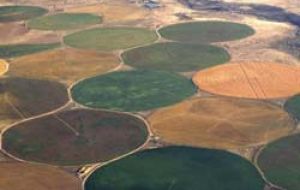MercoPress. South Atlantic News Agency
Satellite data provide new way to monitor groundwater in agricultural regions
 Centre-pivot irrigation systems produce the familiar circles seen by airline passengers.
Centre-pivot irrigation systems produce the familiar circles seen by airline passengers. When you dive into that salad full of lettuce grown in the United States West, there’s a good chance you are enjoying the product of irrigation from an underground water source. These hidden groundwater systems are precious resources that need careful management, but regulatory groups have a hard time monitoring them, owing to a lack of accurate data.
Now, scientists at Stanford have found a way to cheaply and effectively monitor aquifer levels in agricultural regions using data from satellites that are already in orbit mapping the shape of Earth’s surface with millimetre precision.
The amount of water in a groundwater system typically grows and shrinks seasonally. Rainfall and melted snow seep down into the system in the cooler months, and farmers pull water out to irrigate their crops in the warmer, drier months.
In agricultural regions, groundwater regulators have to monitor aquifer levels carefully to avoid drought. They make do with direct measurements from wells drilled into the aquifers, but wells are generally few and far between compared to the vast size of most groundwater systems.
“Groundwater regulators are working with very little data and they are trying to manage these huge water systems based on that,” said Jessica Reeves, a geophysics doctoral student. But now, Reeves has shown how to get more data into the hands of regulators, with satellite-based studies of the ground above an aquifer.
Reeves presented her results Dec. 13 at the American Geophysical Union annual meeting in San Francisco.
As the amount of water in an aquifer goes up and down, specialized satellites can detect the movements of the land above the water system and hydrologists can use that information to infer how much water lies below. Previously, accurate elevation data could only be acquired on barren lands such as deserts. Plants — especially growing crops, whose heights change almost daily — create “noise” in data collected over time, reducing their quality.
Now, a team of scientists led by Reeves has found a way around this “growing” problem.
The study began as collaboration between Reeves’ faculty advisers, Rosemary Knight, a geophysicist who studies groundwater systems, and Howard Zebker, a geophysicist and electrical engineer who uses satellite-based remote sensing techniques to study the Earth’s surface. Knight and Zebker hoped that the combination of their expertise, and the efforts of their graduate student, would lead to new ways of using satellite data for groundwater management.
Reeves analyzed a decade’s worth of surface elevation data collected by satellites over the San Luis Valley in Colorado. Although the valley is rich with growing crops, Reeves and her advisers hoped that recent advances in data-processing techniques would allow her to gain an understanding of the aquifer that lay below.
As part of her analysis, Reeves produced maps of satellite measurements in the valley and saw a regular pattern of brightly coloured high-quality data in a sea of dark, low-quality data. After overlaying the maps with a Google Earth image of the farmland, the team realized that the points of high-quality data were in the dry, plant-free gaps between circles of lush crops on the farms.
In the San Luis Valley, the majority of irrigation is done by centre-pivot irrigation systems. Like a hand on a clock, a line of sprinklers powered by a motor moves around, producing the familiar circles seen by airline passengers.
The circles don’t overlap, leaving small patches of arid ground that don’t receive any water and so don’t have any plants growing on them.
Reeves confirmed that these un-vegetated data points were trustworthy by comparing the satellite data to data collected from wells in the area — exactly the kind of proof that would be important to hydrologists studying aquifers.
The satellites use inter-ferometric synthetic aperture radar, known as InSAR. It is a radar technique that measures the shape of the surface of Earth and can be used to track shape changes over time. Earth scientists often use InSAR to measure how much the ground has shifted after an earthquake.
While continuously orbiting, a satellite sends an electromagnetic wave down to the surface. The wave then bounces back up and is detected by the satellite. The properties of the wave tell scientists how far the wave travelled before it was reflected back. This distance is directly related to the position of the ground.
After the satellite completes a circle around the globe, it returns to the same location to send down another radar wave and take another measurement. Measurements are taken every 35 days and data collection can go on for years.
Compared to drilling wells for monitoring groundwater aquifers, using InSAR data would be much cheaper and provide many more data points within a given area. Traditional methods rely on wells that were not built with scientific data sampling in mind and their results can be inconsistent. Moreover, the number of wells drilled into any particular aquifer is much too small to be able to cover the entire groundwater system.
Hydrologists and regulatory bodies looking for more data to better understand their groundwater system could one day set policies requiring farmers to leave a patch of land clear for InSAR data collection. Furthermore, the technique could be used in agricultural regions anywhere in the world, even those that lack modern infrastructure such as wells.
“I think it really has potential to change the way we collect data to manage our groundwater,” said Reeves. (Go Green).




Top Comments
Disclaimer & comment rulesCommenting for this story is now closed.
If you have a Facebook account, become a fan and comment on our Facebook Page!